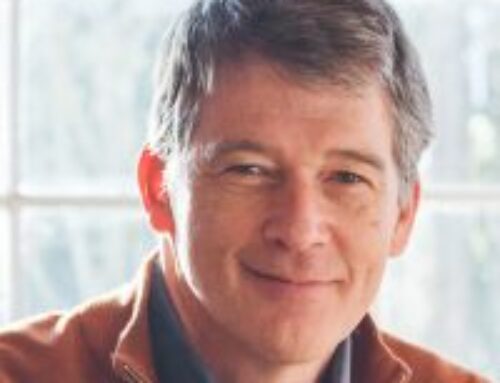Every year I take the Gutenberg College freshman in my art seminar to the Portland Art Museum. Their personal viewing of modern abstract art (Rothko, Pollock, Kline, Motherwell, et al.) produces everything from wonder and intrigue to puzzlement and frustration. Prior to a recent museum visit, one student revealed that he did not “get” abstract paintings and had zero interest in them. Yet, near the end of our visit, I found him standing mesmerized by a very large abstract painting. He explained that he was taken by the painting’s visual imagery but had no clue what it was about or how to go about understanding why he liked it. This abstract painting had grabbed him, but how it had done so completely eluded him.
As an artist who uses abstraction in some of my work, I often find myself trying to explain my abstract forms and why I choose to work in this non-representational way. In this essay, I want to briefly discuss the nature of modern abstract art, including why it appeared so forcefully in the twentieth century. I want to explain, as best I can, some why’s and how’s of non-objective, or abstract, art. I will write mostly about painting, although other art forms—sculpture, music, architecture, etc.—also participate in the modernist abstraction movement. Before I begin, though, I will briefly address a few common questions about abstract art.
Preliminary Questions
First, what is meant by the term abstract? The dictionary generally defines it as “having only intrinsic form with little or no attempt at pictorial representation or narrative content.” To abstract an object is to indirectly retain its essential nature without directly copying the object or conveying its specific appearance. For example, Vincent Van Gogh’s famously volatile swirls of paint in Starry Night are a visual abstraction of the real night sky he observed. But we understand through his colorful, emotion-packed abstract brush strokes his intention to evoke a sense of cosmic, transcendent energy in creation.
Second, do artists make abstract art because they cannot draw correctly? While this question reflects a somewhat common belief and may contain a grain of truth in some cases, the great masters of twentieth-century modern abstraction, without exception, painted in abstract styles after having reached high competence in classical drawing skills; the majority were masters at traditional drawing.
Third, can abstract art be beautiful? Though I can answer this question with a resounding “yes,” I must be careful to admit the complexities involved in trying to answer the question, and I will not deal with them here. Perhaps I can make my point, however, by alluding to those experiences we all have of walking into a forest or garden of exceptional splendor, and, without adequate verbal means of communicating the array of reasons, we “feel” its beauty. Similarly, we see beauty while lying on our backs on a warm summer afternoon and watching brilliant white cloud formations float over us in wondrous abstract formations. This everyday abstractness is all around us, but we rarely notice it until it claims our attention in unexpected ways.
A Brief History of Abstract Art
Although we mostly associate abstract art with the twentieth century, it has a long history. Early Christian and Byzantine art forms were “abstractions” from what we today call representational realism. We also see it in decorative edges of traditional paintings and illuminated manuscripts. Representational realism, however, became the standard for great art after the Western tradition of painting and sculpture reached its great height in the unsurpassed accomplishments of Da Vinci, Michelangelo, Rafael, and other Renaissance artists who created a tradition of representational imagery. For several centuries, optically and proportionally correct representation of the human body and realistically depicted objects in both interior still lifes and landscapes of mountains, trees, and animals became the standard required for great and successful art. This figural and representational tradition with its apprenticeships, academies, and wealthy patronage ruled from the Renaissance through the mid-nineteenth century. Then, as intellectual and social history shows, the Western mind changed, and art changed with it. The changes in Western culture, intellectual life, and even technology led to and fostered the practice of non-representational visual art.
In the 1830s, the invention of photography altered how artists thought about and practiced painting. Photography could depict portraits, landscapes, and interiors more realistically than painting ever could. Many artists used photography to aid them in constructing “realist” paintings. But artists also began to think about new ways of portraying even the classical subjects of portraits, landscapes, and interior still lifes in their paintings.
Beginning with the great realist/impressionist painter Manet (1832–1883), artists increasingly emphasized being honest about the “truth” of painting—namely, that it is pigment on a flat surface rather than an illusionistic “window” through which one sees a constructed scene. And late nineteenth-century painters, following in the Renaissance tradition, were increasingly fascinated with the aesthetic power of the paint medium itself. They began to see that raw color, thickness, and brush strokes of pigment in themselves carried fresh emotional and image-bearing qualities.
In the 1870s, the French impressionists’ fascination with light and color on the retina of the eye produced the first move toward abstraction and away from realism. Though we now see as serenely beautiful their abdication of realism for abstract, colorist impressions, their work was initially greeted with the public’s and the critics’ negative, even horrified, reviews. A few years later, the post-impressionists—Van Gogh, Gauguin, Seurat and Cezanne—each in his own way created the new visual precedents for two different branches of what was to become modern abstract art: expressionist forms and analytic, reductive geometric forms.
Vincent Van Gogh (1853-1890), with his bold, primary color and emotion-powered brush stroke, initiated the “expressive” style that would by mid-twentieth century be abstract expressionism. This form of abstraction used emotional, subjectively created marks and strokes to convey the artist’s individual psychological response to his or her subject. Van Gogh’s famous Starry Night, Kandinsky’s pure, non-objective forms, and later Pollock’s “drip” paintings manifest this emotionally driven approach to abstraction.
On the other side of the abstraction ledger, the French artist Paul Cezanne (1839–1906) painted still lifes, portraits, and landscapes with the goal of penetrating behind the myriad of particulars in an outdoor scene to find simplified, mostly geometric forms that for him revealed a universal, harmonious structure to all of reality. His beautiful, reductive pictures analyzed and simplified natural landscapes, portraits, and room interiors in a visual search for a hidden, structured order. His approach to painting influenced Picasso’s cubism, Tatlin’s constructivism, Malevich’s suprematism, and Piet Mondrian’s de stijl (‘the style’ in Dutch) movement.
Cultural Context for Abstract Art
Fine or serious art has always been about our most vital ideas, beliefs, and world events—all of which reveal much about the human condition. In its own way, modern abstract art is about this as well. Great art of the twentieth century can be seen as a progressive, unfolding search for finding imagery and visual forms to express the tumultuous spirit of modernity—its visions, possibilities, and its tragic inhumanities.
Early modern art reflected artists’ minds and souls coming to terms with their intellectual and spiritual times as they continued exploring and portraying both the glorious and the tragic ideas, beliefs, and experiences of their day. Along with the invigorating possibilities of a new modern world, new kinds of oppressive, alienating, and inhumane forces revealed themselves; and so the depersonalizing effects of bureaucracy, industrialization, mechanization, and urbanization became the subject of modern art. The unimaginable cruelty loosed in modern warfare pressed hard on the psyche of many artists. The stylistic character of art movements such as expressionism, dada, and surrealism all directly responded to the social and personal insanities of modern life.
Of all the historical and cultural forces working to generate abstract art, however, none was more powerful than the quest for new ideological and spiritual foundations for modern man as Christendom’s intellectual and cultural influence disappeared. The quest for new transcendental universals to replace traditional belief in the God of the Bible energized the creation of abstract art. This quest to find and portray the hidden universal spirituality of all things drove the diverse art of modernist giants like Kandinsky, Malevich, Mondrian, and others.
At its deepest level, great art is inevitably and ultimately an existential, reflective, visual statement of an artist’s view of the human condition. Modernist visions of life and society required new visual representations. Artists felt that new “aesthetic vocabularies” and “visual languages” were required to adequately express the intellectual, psychological, and social-political challenges they faced. Thus artists created new visual forms to convey both the intellectual horizon and spiritual malaise loosed by modernity.
Meaning in Abstract Art
Having all too briefly described the historical and cultural conditions that produced various forms of modern abstract art, I want now to explore the power of abstraction and the nature of its meanings.
The most fundamental impulses of early abstraction were generated by artists’ desire to depict their impassioned responses to the world around them. They believed that non-objective marks and strokes and the use of primary color (rather than traditional earth-toned color) could successfully and passionately convey “the truth” of intellectual and psychological moods fostered by the experience of the modern world. Psychological research has confirmed their belief. Studies have shown, for example, that troubled children embed their emotional state into their drawings by the marks they make and the colors they choose. There exists a decipherable, albeit allusive, connection between our inner emotional experiences and our drawings and doodlings and even our scribbling.
Visual marks—shape, color, tone—once laid down, can also evoke independent subjective responses in viewers. The art maker creates with subjective, intentional meanings in mind; the art viewer responds by trying to understand the artist’s subjective intentions but also by subjectively constructing an independent, personally significant reading of the art work. This allusive kind of communication is also at play for the composer and the listener of instrumental jazz or classical music. The harmonies, dissonances, and complex tonal variations of sound without lyrics communicate a distinct mental and emotional experience. There are identifiable and varying degrees of “objective meanings” in the purely instrumental works of Tchaikovsky’s Symphony #1 in G minor and John Coltraine’s Love Supreme. There are ways and means for communicating without words things like beauty, anger, ugliness, anxiety, and sadness. Both music and non-representational art own this power.
The abstract artist’s intentions often focus on conveying sensibilities and emotional states rather than objectively recognizable propositions. Let me give some examples to illustrate what I mean.
The surface of a sheet of highly polished steel has a very different “feel” from that of a surface covered in deep brown velvet cloth, even though the surfaces are the same shape and size. Even visually we “feel” the character of each surface. Similarly, a dark black charcoal line slashed in a barely controlled manner across a paper surface conveys a completely different message from that of a precise thin pencil line drawn with a straight edge. An eight-inch blob of crimson red paint on a white surface conveys a very different sensibility to us from that of a pure white square on a muted gray-paper surface. An anguished scream ”feels” totally different from a mother’s soft, non-verbal humming to her baby. My point here is this: marks, lines, patterns, colors, textures, and shapes convey energy, movement, mood, and an unending variety of feelings through their millions of possible combinations. These recognized principles of visual composition and communication are just as present in abstract art as they are in traditional representational art. Representational art just communicates more directly because it utilizes recognizable, real-world objects and scenes.
When viewing an abstraction, we notice and appreciate the surface beauty of its form, but we inevitably go on to ask if meaning exists behind its visual beauty. Let us take an example from nature. Do the striking patterns on a carefully and meditatively observed rock or leaf mean and convey something? Yes, but the meaning conveyed is interpretively open—that is, the meaning depends on what the viewer brings to the viewing and meditating. Furthermore, appreciating the rock’s or the leaf’s beauty exists at two levels. Someone believing in a Creator of nature will likely derive a very different meaning behind abstract and intricately beautiful natural forms from someone who does not hold that belief.
Viewing human-made abstract art is like viewing the natural abstraction: we first appreciate its aesthetic form, and then we try to understand its meaning as a humanly made work. Unavoidably, abstract, non-objective art forms require a more engaged response by viewers because although abstract art embodies the artists’ intentions, those intentions are indirect and allusive, imbedded into the art by the artists. But in varying degrees, all art communicates through what the artist puts into the art and how the viewer subjectively experiences and questions the art. The abstract artist’s aesthetic strategy to communicate something requires the viewer’s “work.”
Approaching and Understanding Abstract Art
Finally, then, here are some closing thoughts about how to gain an even better understanding and appreciation of this art form that so profoundly manifests the modern human quest for truth in a world that has largely rejected God and transcendence.
First, the internet offers a wealth of short and longer essays on the history of modern abstract art movements. Getting a general grasp of art history from the impressionists through the mid-twentieth century abstract expressionist movement can be immensely helpful. Even more help comes from reading about an artist and reading from the modern artists’ own writings.
Second, when viewing abstract art, give attention to your sense of the moods and feelings conveyed to you by the marks, colors, shapes, and forms you are seeing. Let go of trying to see specific objective content like that offered in representational art forms. You can learn to “read” the sensibilities communicating through the variations of color, shape, texture, and form, just as you can learn to “read” an instrumental symphony or jazz performance. And, if you like what you see on the aesthetic level but cannot decipher the artist’s intentions or meaning, then doing a little homework on the artist will reveal much. Understanding serious fine art requires a similar effort to understanding any serious human discipline—be it philosophy or convoluted historical narratives.
Third, ask yourself what motive, circumstance, idea, or reflective ponderings in the artist drove his or her work into existence? Admittedly, this can be a difficult question to answer, but I think it is perhaps the most essential and revealing question that can be asked of any artwork.
Great modernist abstract art manifests the deepest philosophical and spiritual concerns of twentieth-century man. In many ways, understanding it pays the rich reward of experiencing the exultation and tragedy of the failed modernist vision of life. And the continued intelligent use of its peculiar visual language holds unending possibilities for aesthetically exploring and communicating the inner and outer worlds with which we all live.





